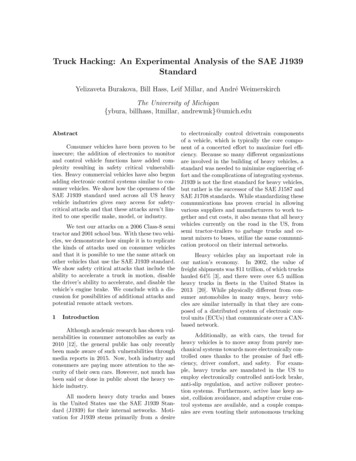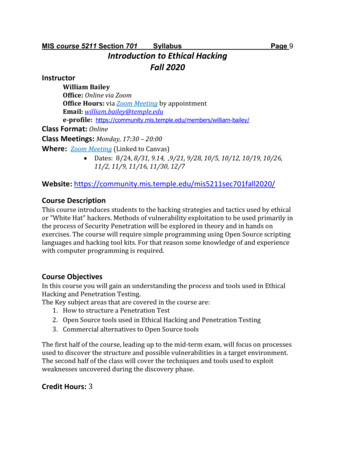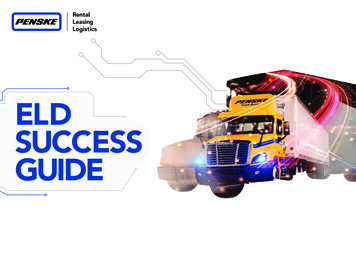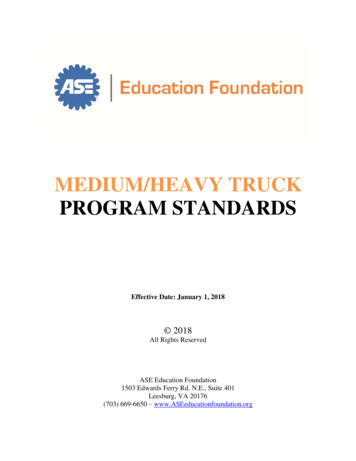
Transcription
Truck Hacking: An Experimental Analysis of the SAE J1939StandardYelizaveta Burakova, Bill Hass, Leif Millar, and André WeimerskirchThe University of Michigan{ybura, billhass, ltmillar, andrewmk}@umich.eduAbstractConsumer vehicles have been proven to beinsecure; the addition of electronics to monitorand control vehicle functions have added complexity resulting in safety critical vulnerabilities. Heavy commercial vehicles have also begunadding electronic control systems similar to consumer vehicles. We show how the openness of theSAE J1939 standard used across all US heavyvehicle industries gives easy access for safetycritical attacks and that these attacks aren’t limited to one specific make, model, or industry.We test our attacks on a 2006 Class-8 semitractor and 2001 school bus. With these two vehicles, we demonstrate how simple it is to replicatethe kinds of attacks used on consumer vehiclesand that it is possible to use the same attack onother vehicles that use the SAE J1939 standard.We show safety critical attacks that include theability to accelerate a truck in motion, disablethe driver’s ability to accelerate, and disable thevehicle’s engine brake. We conclude with a discussion for possibilities of additional attacks andpotential remote attack vectors.1IntroductionAlthough academic research has shown vulnerabilities in consumer automobiles as early as2010 [12], the general public has only recentlybeen made aware of such vulnerabilities throughmedia reports in 2015. Now, both industry andconsumers are paying more attention to the security of their own cars. However, not much hasbeen said or done in public about the heavy vehicle industry.to electronically control drivetrain componentsof a vehicle, which is typically the core component of a concerted effort to maximize fuel efficiency. Because so many different organizationsare involved in the building of heavy vehicles, astandard was needed to minimize engineering effort and the complications of integrating systems.J1939 is not the first standard for heavy vehicles,but rather is the successor of the SAE J1587 andSAE J1708 standards. While standardizing thesecommunications has proven crucial in allowingvarious suppliers and manufacturers to work together and cut costs, it also means that all heavyvehicles currently on the road in the US, fromsemi tractor-trailers to garbage trucks and cement mixers to buses, utilize the same communication protocol on their internal networks.Heavy vehicles play an important role inour nation’s economy. In 2002, the value offreight shipments was 11 trillion, of which truckshauled 64% [3], and there were over 6.5 millionheavy trucks in fleets in the United States in2013 [20]. While physically different from consumer automobiles in many ways, heavy vehicles are similar internally in that they are composed of a distributed system of electronic control units (ECUs) that communicate over a CANbased network.Additionally, as with cars, the trend forheavy vehicles is to move away from purely mechanical systems towards more electronically controlled ones thanks to the promise of fuel efficiency, driver comfort, and safety. For example, heavy trucks are mandated in the US toemploy electronically controlled anti-lock brake,anti-slip regulation, and active rollover protection systems. Furthermore, active lane keep asAll modern heavy duty trucks and buses sist, collision avoidance, and adaptive cruise conin the United States use the SAE J1939 Stan- trol systems are available, and a couple compadard (J1939) for their internal networks. Moti- nies are even touting their autonomous truckingvation for J1939 stems primarily from a desire
capabilities [2]. These systems bring electroniccontrol to safety critical components which necessitates a focus on robustness, reliability, andsecurity.2. We demonstrate that safety critical systemsare vulnerable to an adversary with accessto the vehicle’s internal network through thediagnostics port.Heavy trucks are typically part of a largerfleet of vehicles which are monitored overlong distances using fleet management systems(FMS). The FMS standard is a worldwide standard developed in 2002 which combines satelliteand cellular communication to provide information about vehicle location and status. Some status messages defined by FMS include vehicle anddriver identification as well as the state of theelectronic engine controller, cruise control module, and fuel levels [6]. The FMS standard enables third party systems to integrate with theAPI across manufacturers which is a nice benefit for fleet owners, but as we’ve seen in theconsumer segment, third party devices don’t always prioritize security [4]. In fact, a blogpost inMarch, 2016 [16] revealed over 1,500 third partyfleet management systems with connection to thevehicle’s internal network whose Telnet port waswide open. This indicates a viable long-range attack surface on heavy vehicles.3. We verify that attacks developed on a semitractor also work on a bus, providing evidence that all heavy vehicles with the J1939standard are affected.4. We provide an outlook on further attacksthat are highly likely to be successful andgive recommendations for future areas of research.1.2OverviewWe first cover related work, provide termsfrom the heavy vehicle industry, and present atechnical overview of CAN and J1939 in Section2. Then, in Section 3 we describe our threatmodel, and Section 4 covers our methodology.We present our results in Section 5, followed by adiscussion of the individual attacks. We end withfuture work in Section 6 and give our conclusionin Section 7.In this paper, we focus on what an adversary can accomplish physically connected to theinternal network, and analyze the impact of insecure ECUs in heavy vehicles that use the J1939standard. This is a topic of concern to manyagencies and parties, including various government agencies, heavy vehicle manufacturers, thefreight industry, and of course the general public.Our goal was to experimentally analyze the security of the J1939 protocol and determine whetherheavy vehicles are more or less secure than consumer automobiles.22.1BackgroundRelated WorkRecent attention has been paid to consumerautomobile security thanks to several prominentdemonstrations of vehicle vulnerabilities on anunnamed car in 2010 [12], a Toyota Prius andFord Escape in 2014 [14], and a Jeep GrandCherokee in 2015 [15]. Notably, exploits werefirst developed and reported using a physical connection to the vehicle’s internal CAN network1.1 Contributionsthrough the car’s on-board diagnostics (OBD-II)We are the first to experimentally demon- port, as is the case in 2010 and 2014. Follow upstrate that heavy vehicle networks are vulnera- research to the 2010 report by some of the sameble to attacks similar to those implemented on authors in 2011 [13] demonstrated a wide arrayconsumer car networks. A strength of our work of remote exploits thanks in part to buffer overis that by focusing on the J1939 standard, our flows at the remote interfaces and a general lackresults can be applied to all vehicles using that of security on behalf of the vehicle system enstandard. We summarize our contributions as gineers. Similarly, the 2015 vulnerabilities wereextensions of the authors’ prior research in 2014,follows:which showed they were able to remotely control the vehicle across the country over a cellular1. Using publicly available information of a network. In a similar manner, we wish to firstcommon, standardized vehicle network, we explore the capabilities of an adversary with ashow that it is possible to mount safety crit- physical connection to the heavy vehicle’s interical attacks.nal network via the OBD port.2
2.1.1 Gross Vehicle Weight Rating (GVWR) - TheGVWR is a commercial vehicle classificationused in the United States based on the maximum loaded weight, ranging from Class-1to Class-8. A Class-8 truck is classified asa truck whose GVWR exceeds 33,000 lbsand requires a Class-A commercial driver’slicense to operate.TerminologyBefore we begin, we will define a few termsfrom the heavy vehicle industry. Control Area Network (CAN) Bus - Thestandard method of communication for electronic modules in automobiles. The mostcommon CAN bus configuration is a twistedpair of wires which are connected to eachmodule in the vehicle that needs to send orreceive data to other modules. Commercial Driver’s License (CDL) - Thedriver’s license that is required to operateheavy vehicles. CAN Message / Frame - A complete2.2 CAN ProtocolCAN2.0B packet that contains various headers, an 8 byte data payload, which itselfThe CAN standard was first developed atis composed of several signals, and various Robert Bosch GmbH in 1983 for the purpose offooters as specified by ISO 11898.networking various electronics modules withoutthe need for a dedicated computer in automo CAN Signal - An individual piece of informa- biles.tion which is contained in the data payloadThe original standard was specified in ISOof a CAN message. It can be one or many11898,which defines the physical and data linkbits in length.layers of the CAN protocol. The most common Electronic Control Unit (ECU) - One of physical layer describes a two wire differentialthe numerous electronic modules that collec- bus, one high and one low voltage wire, termitively constitute the distributed control sys- nated at both ends by a 120-ohm resistor andtem of the vehicle.connected at each node to a transceiver. Thewires are typically twisted together, which gives Foundation / Service Brake - The physicalthe bus a high tolerance for interference as bothbraking mechanism at the wheel ends or axlewires will experience the same level of distorwhich uses friction to cause the truck to detion, leaving the voltage difference between thecelerate.two wires largely unaffected. The data link layer Engine Brake - On heavy vehicles, an im- usually consists of a peripheral micro-controllerportant aspect of braking is the use of the that implements arbitration and packet framingengine to slow down the vehicle. This is es- in hardware which is controlled by the host propecially important when going downhill, as cessor.using foundation brakes for this task wouldData is sent using frames which are also dequickly cause the brakes to overheat. When scribed in the specification. These packets inthe brakes overheat, not only do they wear clude a priority identifier, data length, data paysubstantially faster, but more importantly a load, error detection bits, and an ACK bit. Thepartial or total loss of braking results (Also priority ID and data bytes are the primary comknown as brake fading).ponents of the frame which can be controlled bythe host controller. The original specificationonly allows for up to 8 bytes of data per frameand an 11 bit ID. Since the release of CAN2.0B in1991 [5], an extended frame format was definedthat allows for a 29 bit ID. The extended frameformat can be seen at the top of Figure 1a. Recently, CAN-FD was defined which inter-operates Supplier - Companies that supply OEMs with CAN2.0B and allows up to 64 bytes of datawith various parts or services. Suppliers may per frame. Larger frames will one day enable thesell raw materials, individual parts, or an en- ability to include message authentication codestire system they have designed and devel- with the data, but it will be at least several yearsoped.until CAN-FD is widely adopted. Original Equipment Manufacturer (OEM) The manufacturer of the end product. Therelationship between OEM and suppliers iscomplex. Examples from automotive includeFord, Kenworth, Mercedes-Benz, and General Motors.3
(a) Full CAN frame with 29-bit ID broken down for J1939 protocol(b) Example SPN layout for the “Engine Temperature” PGNFigure 1: Diagrams that describe the J1939 identifier and data fields [21]The messages sent on the bus dependgreatly on the make and model of the vehicle.For example, the messages sent on consumer vehicle networks are proprietary to the OEM thatdesigned that particular vehicle and kept secret.Often times the message formats will change, notonly from model to model within an OEM, butalso from year to year. For this reason, deciphering consumer vehicle network traffic involvesthe tedious process of reverse engineering anymessages observed on the bus to determine theirfunction.2.3requires more data, a set of transport protocolmessages can be used to send up to 1,785 bytesfor a given PGN. The data bytes are grouped using Suspect Parameter Numbers (SPNs) whichdefine what the data means. An example of howPGNs and SPNs relate is shown in Figure 1b .The J1939 standard is open and used acrossmany industries that employ diesel engine vehicles, such as bus and train transportation, construction, agriculture, forestry, mining, and themilitary [18]. This is a very different model fromOEM’s proprietary application level CAN protocols which change across make, model, and modelyear and are heavily guarded secrets within theOEMs.J1939 ProtocolThe SAE J1939 standard describes the vehicle bus used in heavy vehicles such as buses andsemi-trucks. J1939 defines five of the seven layers of the OSI model, with CAN2.0B being usedfor the physical and data-link layers [11]. The 29bit ID encodes a 3 bit priority, 18 bit ParameterGroup Number (PGN), and 8 bit source address,as seen in Figure 1a. The PGN is a message identifier that specifies which signals are contained inthe data payload. In most cases, the data sent fora given PGN consists of 8 bytes, but if a PGNThe openness of J1939 allows anyone whocan make a payment receive technical detailsabout standard PGNs, allowing a potential adversary to easily gain the knowledge necessaryto attack safety critical components. PGNs0x00FF00 through 0x00FFFF are reserved forproprietary use, but every attack described inthis paper uses standard PGNs that are the samefor different vehicles. Interesting messages thatare part of the standard include brake, engine,4
transmission, and cruise control. These messagescould lead to similar vulnerabilities as seen inthe consumer automotive sector. A recent NSFGrant for a J1939 security testbed in Jan. 1,2016 [17] suggests government and heavy trucking industry are starting to analyze the securityimplications of the standard.trace anything is amiss. A common argument tothe physical assumption is that an adversary canalready cut the brakes or loosen some nuts withphysical access, but we think that argument takesa nearsighted view of the threat model. With afoothold in the car’s internal network, vehicle status or external events can be monitored to trigger various behaviors, and the software can avoidforensic analysis by erasing itself.We provide supporting evidence in Section4 to say that attacks developed for the J1939 protocol can potentially be used across a wide variety of vehicles. While there may still be slightimplementation differences from supplier to supplier and some vehicles won’t have certain features implemented, we hypothesize that most basic attacks will work for any vehicle that uses thisstandard.3While our research focused on direct physical access through the OBD port, there are acouple other attack vectors common to heavyvehicles that are worth mentioning. First, isthe trailer in a semi tractor-trailer configuration.Typically, there is a bridge between the J1939network and the trailer network as can be seenin Figure 2, which if exploited could be a viableattack vector. Second, are fleet management sys-Threat ModelIn contrast to the consumer car segment,there is more incentive for an adversary to attack the heavy vehicle industry due to the size ofthe vehicles and the variety of goods they carry.The biggest motivation for an attacker is usuallyfinancial, and the freight transportation industry contributes nearly 10 percent of the UnitedStates GDP [19]. When you add other potentially affected industries such as construction andagriculture, that number only goes up. So our adversary can be anyone who could stand to makea profit off manipulating the vehicles, be it fromhijacking their goods, adversely manipulating acompetition’s fleet, extorting fleet owners anddrivers, or selling their tools and services on theblack market. Another type of adversary we consider is one who wishes to cause the most harmand damage as possible, such as a terrorist ornation state.Figure 2: Tractor-trailer network configurationtems (FMS) which can be found in many commercial vehicles. They are used by fleet ownersto wirelessly track and log various statistics of agiven fleet, from GPS, speed, and brake usage tonotifications in the case of an accident or airbagdeployment. FMS should be read-only from theJ1939 network, but they are complex systemswhich could provide a wireless attack vector.It’s reasonable to assume that given a physical exploit, a remote exploit will soon follow.Many cases of remote attacks in the consumervehicle space derive from physical exploits [13,15, 4]. There has even been at least one documented vulnerability of hardware that is specifically used in trucks today [16]. This particular security flaw was due to an open Telnet portaccessible without authentication on the publicIP space. It’s not news that embedded deviceshave open ports [1], so we can reasonably expectthat this is not the only instance of a telematics unit with an exploitable default configuration.Like FMS, telematics units are used widely in thetrucking industry to track vehicles and many areconnected to CAN to report diagnostics back tothe base.We assume that our adversary has the ability to transmit arbitrary messages on the vehicle’s J1939 bus. This is most readily accomplished with physical access to the vehiclethrough the OBD port. Given that CAN hardware is common and easy to obtain, we can assume that someone with physical access also hasaccess to the correct hardware. With a smallenough dongle, an adversary with brief physicalaccess could gain persistent access to the vehicle’sbus since the OBD port is commonly located outof sight under the dash and is not part of theCDL pre-trip inspection. Alternatively, a moreIt takes more sophisticated knowledge ofsophisticated attacker could inject malware intoother ECUs on the network leaving no external the protocol to understand what messages to5
modify or send in order to get some kind of desired behavior, but the fact that J1939 is an openstandard means that anyone with enough technical skill can craft attacks before even connecting to a vehicle. This differs from consumer vehicles, where the proprietary CAN standard requires significant reverse engineering and narrowsthe possible attackers to people with access to thespecific vehicle’s protocol version. On top of that,an adversary attacking consumer vehicles wouldneed to modify their attack for different modelsof cars, whereas an attack on heavy vehicles canremain unmodified and work on a variety of vehicles, from trucks to buses.Figure 3: Example setup for experimentation.under normal driving conditions, we used public roads due to the limited availability of test4 Methodologying facilities. For these tests, we put our toolsinto listen-only mode so no data packets couldAll of our experiments specifically exploit be injected onto the CAN bus. These sessionsmessages present in J1939 without the use of were aimed at gathering data only to be storedbackdoors or software vulnerabilities. We fo- for later analysis. Once we had collected thatcused primarily on a Class-8 2006 model year data, we went back to the parked and idle setupsemi tractor, and we had limited access to a 2001 to replay the sequence of messages we recorded.model year school bus. Since both use the J1939 Using this method, we discovered a reaction bystandard, our hypothesis was that the exact same the powertrain and other electronic systems.attacks should work on each vehicle, and on anyFinally, we needed to test our attacks whileother vehicle that uses the standard. All of ourthetruckwas in motion in order to realizeattacks were first developed on the semi truckthetrueimpactof our findings. For this, wewhile idling in neutral with the parking brakeusedMCityTheUniversity of Michigan Mobilapplied, then tested on a closed track with a cerityTransformationCenter’s 32-acre closed-coursetified CDL driver while the truck was driven untesttrack.Alloftheexperiments were carriedder normal conditions. Then, for each of our sucoutatlowspeedonaslightuphill gradient withcessful attacks, we also tested them unmodifiedlargeroundaboutsateitherendso that the vehiagainst the school bus while parked and idling toclecouldbeputinneutralandcoastto a stop incheck our hypothesis.case of an emergency.Our test setup is pictured in Figure 3. Weconnected a laptop to the Vector and PEAK tools 4.1 Toolsdescribed in Section 3.1 which were connected toWe used a variety of diagnostic tools to anthe J1939 OBD port via a Y-cable in order to collect and transmit data. The CANoe application alyze the bus traffic and inject our own packets.proved to be the most useful for packet snoop- All of these tools are available to purchase anding thanks to a publicly available Communication are designed for the typical mechanic or engineerDatabase (DBC) file which enabled messages to to use.be parsed and inspected in real-time based onthe J1939 standard. We were quickly able to Vector CANoeidentify PGNs that controlled various functionsThe Vector CANoe is a high-cost, industryof the truck as we manipulated them from withinstandard CAN analysis and simulation softwarethe cabin. The PEAK tool on the other hand wastool. It uses a hardware interface device whichmuch easier to use for packet injection thanks toallows the user to interface via USB with varthe simple, intuitive user interface. By injectingious CAN protocols such as the J1939 standardpackets with the PEAK tool and snooping withor other proprietary protocols that use CAN. Thethe Vector tool, we were able to easily verify oursoftware application allows the user to snoop andinjected messages.record CAN traffic, inject and replay CAN mesIn order to gather data while the truck was sages, and write scripts for efficiently describing6
complex interactions with modules on the bus.It uses a proprietary C-like event-driven scripting language called CAPL. The application layerCAN protocols can be described in the DBCwhich can then be imported to CANoe for realtime identification of the CAN messages and signals on the bus, as well as for easier creation ofscripts.5ResultsWe find that an adversary with network access can control safety critical systems of heavyvehicles using the SAE J1939 protocol. The specific message PGNs for each behavior are listed inTable 1. The instrument cluster attack requireddifferent PGNs to control each gauge, whereas wefound we could get a lot of control from the truckby changing the SPNs within the torque/speedcontrol 1 (TSC1) message. Not only is the TSC1message a public PGN, but the documentationprovides a detailed overview of the purpose ofthe different SPNs associated with it, making thispowerful attack relatively easy to replicate.We used CANoe for data gathering, and ourmore sophisticated attacks were implemented inCAPL and executed using the CANoe system.PEAK USB-PCANThe PEAK tool is a low-cost alternative tothe Vector tool. It is similar in that there is asoftware application and hardware device thatinterfaces between CAN and USB. Its free application, PCAN-view, has fewer features, but it isalso more intuitive and works very well for simple tasks. PEAK provides a set of libraries forinterfacing with PCAN APIs which we used withPython to create a fuzzing script [7] which enumerates all possible data and ID fields. Priorresearch has had success with such fuzzing methods, but we have not. Additionally, the lackof database files which describe the identification and purpose of various messages makes fora much less straightforward experience with thePEAK tool.5.1Instrument ClusterBy spoofing the status messages that originate in various ECUs of the truck, we wereable to control all gauges on the instrument cluster, which include oil temperature, oil pressure,coolant temperature, RPM, speed, fuel level, battery voltage, and air pressure of the foundationbrake system. [8] The temperature, oil pressure, air pressure, fuel level, and battery voltagegauges all cause an alarm to sound accompaniedby a bright red light at each gauge when the reading goes above or below a certain point, and in allcases we were able to make the gauges go beyondsaid thresholds, causing the alarm to sound. Ourcontrol was precise, we could make the gaugesThe PEAK tool was used for data gath- point to the value of our choosing - even whileering, especially while using CANoe, and our the truck was in motion. This attack did notearlier, simple attacks were implemented with work on the 2001 model year bus.PCAN-view and the PEAK tool.For the safety critical rating, we deemedfuel level, battery, and RPM as non-critical beDiagnostics Toolcause the driver has other indicators which can beThe generic diagnostics tool we used had relied on such as odometer and engine noise. Forcapability to retrieve diagnostic codes and gen- speedometer, oil pressure, and temperature, weeral status information about the semi truck it gave a low rating because they are harder to veris connected to. It uses a standard J1939 OBD ify by the driver and could put the driver or otherconnector and is used primarily by mechanics for vehicles on the road in a dangerous situation ifECU diagnostics. We found that the software the underlying system fails. The service brakealso has the option to update ECUs and cut off pressure has moderate severity because the drivereach of the six engine cylinders, one cylinder at has no other indicator and needs to know the aira time, and we found a freely available software pressure to avoid activating the emergency brakemodule from the ABS manufacturer’s website for system which would lock up all of the wheels.the generic diagnostics tool which enabled us to5.2 Powertrainactuate the ABS valves on the wheel ends.We used the diagnostic tool to setup diagThe powertrain attack was somewhatnostics sessions and perform various diagnostics harder to discover, but just as straightforwardtasks while logging the messages with CANoe via to implement. By replaying a sequence of capthe Y-Cable.tured messages that we recorded during normal7
Attack MessagesBehaviorPGNAcronymSafety CriticalSet Oil & Coolant Temperature Gauges0xFEEEET1LowSet Oil Pressure Gauge0xFEEFEFl/P1LowSet Service Brake Pressure Gauge0xFEAEAIR1ModerateSet Speedometer Gauge0xFEF1CCVSLowSet RPM Gauge0xF004EEC1—Set Battery Gauge0xFEF7VEP1—Set Fuel Level Gauge0xFEFCDD1—Increase Engine RPM0x0TSC1HighDecrease Engine RPM0x0TSC1HighDisable Engine Brake0x0TSC1HighTable 1: List of PGNs and attack severitymodification on the 2001 model year school bus.[9]driving conditions, we observed the engine RPMincrease in a specific pattern. There were elevenunique PGNs that repeated at various intervalsrelated to the engine within that sequence, leading us to believe it was a complex interaction ofmessages causing the RPM to spike. However, byshrinking the sequence and probing with specificmessages we were surprised to find that just onePGN, TSC1, enabled powertrain control. [10]According to the specification, the TSC1message is used for engine control and retarding by various ECUs, such as accelerator pedal,cruise control, or power take-off governor. It isreceived by the engine or retarder and commandsa given RPM value if speed control mode is specified or percentage of torque output if torque control mode is specified. We ran further experiments while idle and found that by injecting theTSC1 message with a specified RPM in speedcontrol mode we could physically command theengine’s RPM to that specific value. Torque control mode behaved similarly, but a specific RPMvalue was harder to hit.We developed a set of messages that exercised edge cases of various signals within theTSC1 message for testing on MCity while driving. By commanding the RPM to any value inspeed control mode, we were able to override thedriver’s input. If a high RPM value was issued(e.g. 3000 RPM) we caused the truck to veryquickly accelerate to max out the speed providedby the currently selected gear. This attack didn’twork while the truck was completely stopped orrolling backwards down an incline, but it didwork if the truck was rolling forward. By commanding the torque percentage to a low value(e.g. 0%) in torque control mode, we were ableto override the driver’s input to the accelerator ashe was actively accelerating causing the truck’sengine to idle; effectively cutting off the engine.This even prevented the driver from acceleratingfrom a standstill. The TSC1 message also hadother side effects explained in the engine brakesection below.After seven seconds of continuous control,the engine wouldn’t obey our messages and returned to idle, but we quickly overcame this limitation by pausing for 40ms before the seven second timeout expired, then repeating. With just a40ms pause, we could indefinitely hold the RPMto a given value. We did not try to blow the engine. This attack also worked while idle withoutTo summarize, we were able to override thedriver’s input to the accelerator pedal and simultaneously cause either direct acceleration or remove the ability to provide torque to the wheelswhile the truck was in motion. We gave both ahigh safety critical rating because the CAN message directly influences the vehicle’s engine without operator control; the best the driver can do8
is brake and pull over which isn’t possible in allsituations.5.3insecure. Additionally, for those models that aresecure, the level of sophistication that would berequired to bypass their security enough to writemalicious packets on the CAN bus or
Truck Hacking: An Experimental Analysis of the SAE J1939 Standard Yelizaveta Burakova, Bill Hass, Leif Millar, and Andr e Weimerskirch The University of Michigan fybura, billhass, ltmillar, andrewmkg@umich.edu Abstract Consumer vehicles have been proven to be insecure; the addition of electronics to monitor and control vehicle functions have .










![Bosch ESI[truck] Heavy Duty Truck Software Update – Q2 .](/img/22/bosch-esitruck-heavy-duty-truck-release-notes-details-2019-2-0-0-0.jpg)